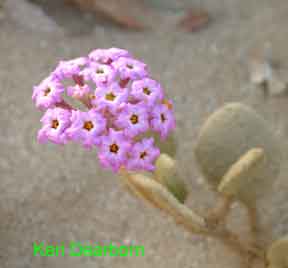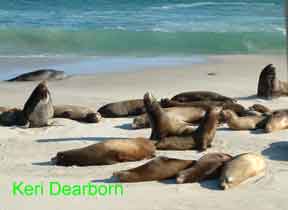Experiencing San Nicolas Island
Island Journal - Summer 2008
 Visiting California’s San Nicolas Island is a unique opportunity. This remote and wind-swept island is owned by the United States Navy. Friends of the Island Fox President, Pat Meyer, and I were fortunate to receive a special invitation for a short visit.
Visiting California’s San Nicolas Island is a unique opportunity. This remote and wind-swept island is owned by the United States Navy. Friends of the Island Fox President, Pat Meyer, and I were fortunate to receive a special invitation for a short visit.
 At first glance, the treeless slopes seem barren, but life here clings low to the ground to survive shifting wind. Delicate verbena flowers rise up from the sandy soil. Giant coreopsis, a species unique to the Channel Islands and the Southern California coast, stand like a forest of gray stick figures. This member of the daisy family grows several feet tall on a woody stem. In spring, the dried trunks come back to life and produce pompoms of lacy green topped with brilliant yellow flowers. (coreopsis photo)
At first glance, the treeless slopes seem barren, but life here clings low to the ground to survive shifting wind. Delicate verbena flowers rise up from the sandy soil. Giant coreopsis, a species unique to the Channel Islands and the Southern California coast, stand like a forest of gray stick figures. This member of the daisy family grows several feet tall on a woody stem. In spring, the dried trunks come back to life and produce pompoms of lacy green topped with brilliant yellow flowers. (coreopsis photo)
Now, in July, the stems are dormant again, but the coreopsis forest is gradually spreading across 10% of the island. It is a clear sign that native plants are returning.
San Nicolas currently has the largest island fox population and the greatest number of foxes per square kilometer. We came hoping to see wild island foxes and the island didn’t disappoint us.
 We were even lucky enough to see a litter of four pups born this spring. They were about 2 months old and bold little explorers. This is dad with one of the pups in the early morning fog.
We were even lucky enough to see a litter of four pups born this spring. They were about 2 months old and bold little explorers. This is dad with one of the pups in the early morning fog.
Gazing across the dunes and scrub, it is hard to imagine there is enough cover to hide a fox, but the San Nicolas island foxes are tiny. The individuals we saw were slighter in weight and shorter, than the Catalina island foxes. It might seem impossible, but an island fox can emerge from the short grass along the roadside in a flash and be unseen until the instant it is in front of a car. Signs warning “Watch for Foxes” dot the few roads trying to alert unexpecting drivers. (road signs)
 Most of the 12 island foxes we saw were wearing radio collars. Radio-collared foxes can be monitored by biologists and a new automated tracking system is being tested so that the movement of island foxes can be recorded in detail. The biologists are hoping this will provide greater understanding of island fox interactions and territories. Radio-collars also provide the first alert warning system for threats to island fox populations. (more on radio collars)
Most of the 12 island foxes we saw were wearing radio collars. Radio-collared foxes can be monitored by biologists and a new automated tracking system is being tested so that the movement of island foxes can be recorded in detail. The biologists are hoping this will provide greater understanding of island fox interactions and territories. Radio-collars also provide the first alert warning system for threats to island fox populations. (more on radio collars)
Dunes and grassland might seem inhospitable to a little fox, but it seems that sand fly larva may be providing an important food source for these foxes.
San Nicolas is a unique ecosystem and also home to endangered island night lizards and snowy plover. We saw one snowy plover and a number of other shore birds, including Western gull chicks. The beaches were busy with breeding California sea lions and resting immature elephant seals.
 At night, sea lion barks hauntingly drifted up from the beaches. Fog streaked over the dry land. Here and there the wind would tear open a hole to expose the dark black sky with brilliant white stars.
At night, sea lion barks hauntingly drifted up from the beaches. Fog streaked over the dry land. Here and there the wind would tear open a hole to expose the dark black sky with brilliant white stars.
San Nicolas Island is a wedge of sandstone cliffs carved by the waves of the Pacific Ocean. A unique landscape and home to the San Nicolas Island fox. - Keri Dearborn
Links to
Experiencing Santa Cruz Island
Experiencing Santa Rosa Island
 Visiting California’s San Nicolas Island is a unique opportunity. This remote and wind-swept island is owned by the United States Navy. Friends of the Island Fox President, Pat Meyer, and I were fortunate to receive a special invitation for a short visit.
Visiting California’s San Nicolas Island is a unique opportunity. This remote and wind-swept island is owned by the United States Navy. Friends of the Island Fox President, Pat Meyer, and I were fortunate to receive a special invitation for a short visit. At first glance, the treeless slopes seem barren, but life here clings low to the ground to survive shifting wind. Delicate verbena flowers rise up from the sandy soil. Giant coreopsis, a species unique to the Channel Islands and the Southern California coast, stand like a forest of gray stick figures. This member of the daisy family grows several feet tall on a woody stem. In spring, the dried trunks come back to life and produce pompoms of lacy green topped with brilliant yellow flowers. (coreopsis photo)
At first glance, the treeless slopes seem barren, but life here clings low to the ground to survive shifting wind. Delicate verbena flowers rise up from the sandy soil. Giant coreopsis, a species unique to the Channel Islands and the Southern California coast, stand like a forest of gray stick figures. This member of the daisy family grows several feet tall on a woody stem. In spring, the dried trunks come back to life and produce pompoms of lacy green topped with brilliant yellow flowers. (coreopsis photo)Now, in July, the stems are dormant again, but the coreopsis forest is gradually spreading across 10% of the island. It is a clear sign that native plants are returning.
San Nicolas currently has the largest island fox population and the greatest number of foxes per square kilometer. We came hoping to see wild island foxes and the island didn’t disappoint us.
 We were even lucky enough to see a litter of four pups born this spring. They were about 2 months old and bold little explorers. This is dad with one of the pups in the early morning fog.
We were even lucky enough to see a litter of four pups born this spring. They were about 2 months old and bold little explorers. This is dad with one of the pups in the early morning fog.Gazing across the dunes and scrub, it is hard to imagine there is enough cover to hide a fox, but the San Nicolas island foxes are tiny. The individuals we saw were slighter in weight and shorter, than the Catalina island foxes. It might seem impossible, but an island fox can emerge from the short grass along the roadside in a flash and be unseen until the instant it is in front of a car. Signs warning “Watch for Foxes” dot the few roads trying to alert unexpecting drivers. (road signs)
 Most of the 12 island foxes we saw were wearing radio collars. Radio-collared foxes can be monitored by biologists and a new automated tracking system is being tested so that the movement of island foxes can be recorded in detail. The biologists are hoping this will provide greater understanding of island fox interactions and territories. Radio-collars also provide the first alert warning system for threats to island fox populations. (more on radio collars)
Most of the 12 island foxes we saw were wearing radio collars. Radio-collared foxes can be monitored by biologists and a new automated tracking system is being tested so that the movement of island foxes can be recorded in detail. The biologists are hoping this will provide greater understanding of island fox interactions and territories. Radio-collars also provide the first alert warning system for threats to island fox populations. (more on radio collars)Dunes and grassland might seem inhospitable to a little fox, but it seems that sand fly larva may be providing an important food source for these foxes.
San Nicolas is a unique ecosystem and also home to endangered island night lizards and snowy plover. We saw one snowy plover and a number of other shore birds, including Western gull chicks. The beaches were busy with breeding California sea lions and resting immature elephant seals.
 At night, sea lion barks hauntingly drifted up from the beaches. Fog streaked over the dry land. Here and there the wind would tear open a hole to expose the dark black sky with brilliant white stars.
At night, sea lion barks hauntingly drifted up from the beaches. Fog streaked over the dry land. Here and there the wind would tear open a hole to expose the dark black sky with brilliant white stars.San Nicolas Island is a wedge of sandstone cliffs carved by the waves of the Pacific Ocean. A unique landscape and home to the San Nicolas Island fox. - Keri Dearborn
Links to
Experiencing Santa Cruz Island
Experiencing Santa Rosa Island
Labels: California sea lion, captive breeding of island fox, Channel Island fox, elephant seal, giant coreopsis, island night lizard, island verbena, San Nicolas Island, San Nicolas Island fox, snowy plover


